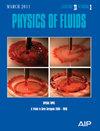Enhancement of the subcritical boiling heat transfer in microchannels by a flow-induced vibrating cylinder
IF 4.1
2区 工程技术
Q1 MECHANICS
引用次数: 0
Abstract
The flow boiling heat transfer in microchannels has been extensively used in engineering due to its high heat dissipation with a small temperature difference. This study employs a hybrid method to numerically investigate the effects of a flow-induced vibrating cylinder on enhancing the subcritical boiling heat transfer in microchannels. The hybrid approach integrates the pseudopotential multiphase lattice Boltzmann method for modeling unsteady flows, the finite difference method for solving the heat transfer equation, and the immersed boundary method for handling the boundary condition at the fluid–cylinder interface. Flow boiling simulations in the microchannel are performed for three setups: a smooth vertical channel, a vertical channel with a stationary cylinder, and a vertical channel with a flexibly supported cylinder. Simulations have been conducted by varying the Reynolds number based on the diameter of the cylinder (Red) from 35 to 333.3, the dimensionless boiling number (Bo) from 0.001 84 to 0.045 97, and blockage ratio (BR) of 3.0, 4.0, and 5.0. It is found that the vortical wake of the cylinder is important in enhancing the heat transfer in microchannels, which is quantified by the (Red). Specifically, when Red<48.0, both stationary and flexibly supported cylinders have almost the same effect on heat transfer during the flow boiling process, as there is no vortex shedding from both cylinders; when 48.0≤Red<68.2, the flexibly supported cylinder achieved higher enhancement than the stationary cylinder, which is due to the vortical wake generated by the flow-induced vibration in a subcritical Reynolds number regime; when 68.2≤Red, both stationary and flexibly supported cylinders have comparable effect on the rates of heat transfer, because both cylinders generate similar vortical wakes. Flow field analysis indicates that the disturbance due to the vortex wakes on the thermal boundary and/or the vapor insulation layer is the mechanism of the heat transfer enhancement in channels.通过流动诱导振动筒增强微通道中的亚临界沸腾传热
微通道中的流动沸腾传热因其温差小、散热量大而在工程中得到广泛应用。本研究采用混合方法数值研究了流动诱导振动圆柱体对提高微通道亚临界沸腾传热的影响。该混合方法集成了用于模拟非稳态流动的伪势多相晶格玻尔兹曼法、用于求解传热方程的有限差分法以及用于处理流体-圆筒界面边界条件的沉浸边界法。微通道中的流动沸腾模拟有三种设置:光滑的垂直通道、带有固定圆柱体的垂直通道和带有柔性支撑圆柱体的垂直通道。模拟时改变了基于圆柱体直径的雷诺数(Red)(从 35 到 333.3)、无量纲沸腾数(Bo)(从 0.001 84 到 0.045 97)以及阻塞比(BR)(3.0、4.0 和 5.0)。研究发现,气缸的涡流尾流对增强微通道的传热非常重要,这可以用(Red)来量化。具体来说,当Red<48.0时,固定圆筒和柔性支撑圆筒在流动沸腾过程中对传热的影响几乎相同,因为两个圆筒都没有涡流脱落;当48.0≤Red<68.2时,柔性支撑圆筒比固定圆筒获得了更高的增强效果,这是由于在次临界雷诺数条件下,流动引起的振动产生了涡旋唤醒;当68.2≤Red时,固定圆筒和柔性支撑圆筒对传热速率的影响相当,因为两个圆筒都产生了类似的涡旋唤醒。流场分析表明,热边界和/或隔汽层上的涡旋漩涡造成的扰动是通道传热增强的机制。
本文章由计算机程序翻译,如有差异,请以英文原文为准。
求助全文
约1分钟内获得全文
求助全文
来源期刊

Physics of Fluids
物理-力学
CiteScore
6.50
自引率
41.30%
发文量
2063
审稿时长
2.6 months
期刊介绍:
Physics of Fluids (PoF) is a preeminent journal devoted to publishing original theoretical, computational, and experimental contributions to the understanding of the dynamics of gases, liquids, and complex or multiphase fluids. Topics published in PoF are diverse and reflect the most important subjects in fluid dynamics, including, but not limited to:
-Acoustics
-Aerospace and aeronautical flow
-Astrophysical flow
-Biofluid mechanics
-Cavitation and cavitating flows
-Combustion flows
-Complex fluids
-Compressible flow
-Computational fluid dynamics
-Contact lines
-Continuum mechanics
-Convection
-Cryogenic flow
-Droplets
-Electrical and magnetic effects in fluid flow
-Foam, bubble, and film mechanics
-Flow control
-Flow instability and transition
-Flow orientation and anisotropy
-Flows with other transport phenomena
-Flows with complex boundary conditions
-Flow visualization
-Fluid mechanics
-Fluid physical properties
-Fluid–structure interactions
-Free surface flows
-Geophysical flow
-Interfacial flow
-Knudsen flow
-Laminar flow
-Liquid crystals
-Mathematics of fluids
-Micro- and nanofluid mechanics
-Mixing
-Molecular theory
-Nanofluidics
-Particulate, multiphase, and granular flow
-Processing flows
-Relativistic fluid mechanics
-Rotating flows
-Shock wave phenomena
-Soft matter
-Stratified flows
-Supercritical fluids
-Superfluidity
-Thermodynamics of flow systems
-Transonic flow
-Turbulent flow
-Viscous and non-Newtonian flow
-Viscoelasticity
-Vortex dynamics
-Waves
 求助内容:
求助内容: 应助结果提醒方式:
应助结果提醒方式:


